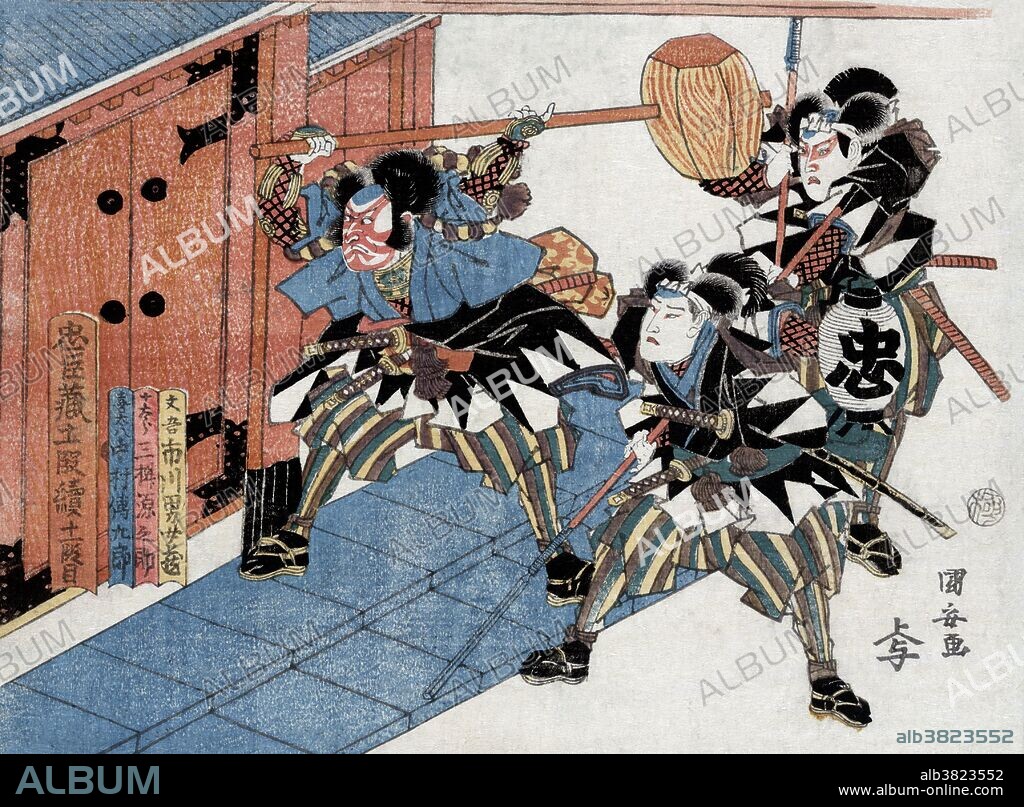alb3823552
Chushingura, Revenge of the 47 Ronin, 18th Century

|
Ajouter à une autre Lightbox |
|
Ajouter à une autre Lightbox |



Avez-vous déjà un compte? S'identifier
Vous n'avez pas de compte ? S'inscrire
Acheter cette image

Titre:
Chushingura, Revenge of the 47 Ronin, 18th Century
Légende:
Voir la traduction automatique
Entitled: "Juichidanme". Act eleven of the Chushingura. Print showing three Ronin samurai attacking the entrance Kira Yoshinaka's home. Chushingura is the title given to fictionalized accounts in Japanese literature, theater, and film that relate the historical incident involving the Forty-seven Ronin. The story tells of a group of samurai who were left leaderless (becoming ronin) after their daimyo (feudal lord) Asano Naganori was compelled to commit seppuku (ritual suicide) for assaulting a court official named Kira Yoshinaka. The ronin avenged their master's honor by killing Kira, after waiting and planning for a year. In turn, the ronin were themselves obliged to commit seppuku for committing the crime of murder. This true story was popularized in Japanese culture as emblematic of the loyalty, sacrifice, persistence, and honor that people should preserve in their daily lives. The historical basis for the narrative began in 1701. Woodcut by Kuniyasu Utagawa, published circa 1815-18.
Crédit:
Album / LOC/Science Source
Autorisations:
Modèle: Non - Propriété: Non
Questions sur les droits?
Questions sur les droits?
Taille de l'image:
4350 x 3204 px | 39.9 MB
Taille d'impression:
36.8 x 27.1 cm | 14.5 x 10.7 in (300 dpi)
Mots clés:
18 18E 18EME XVIII XVIIIE XVIIIEME SIECLE • 18E SIECLE • 18EME S • BOIS, GRAVURE SUR • CÉLÈBRE • CELEBRITE • CHEVALERIE • DIX-HUITIÈME SIÈCLE • ÉVÉNEMENT • GRAVURE SUR BOIS • GRAVURE TAILLE DOUCE • HOMME • ILLUSTRATION • JAPON • JAPONAIS • JAPONAISE • ORNEMENT, JAPONAIS • RONIN • SAMOURAI • TAILLE-DOUCE • TECHNIQUE: GRAVURE SUR BOI • XVIIIE SIECLE • XYLOGRAPHIE
 Pinterest
Pinterest Twitter
Twitter Facebook
Facebook Copier le lien
Copier le lien Email
Email
